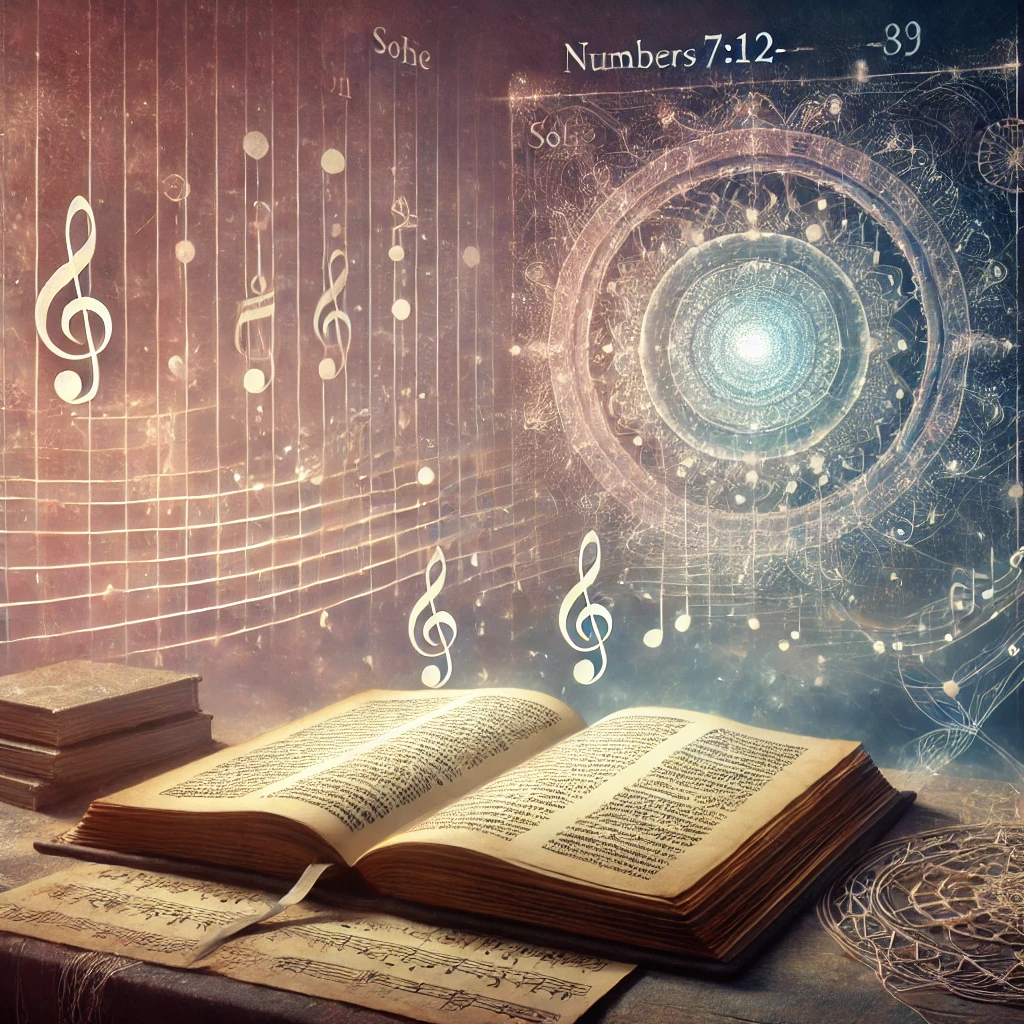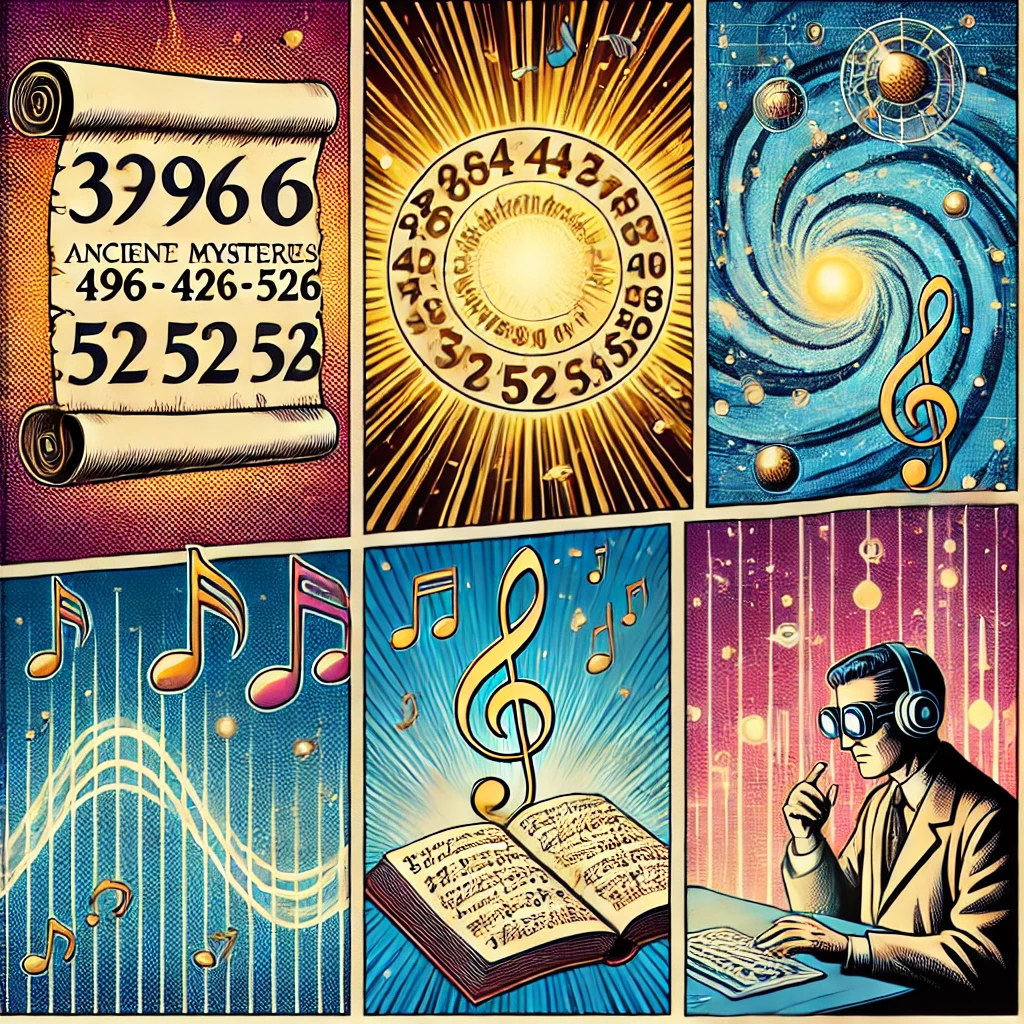The Bible, Numbers 7:12-89, and the Solfege Scale
Abstract
Dr Joseph Puleo discovered a pattern of six repeating codes he claimed he had uncovered within the bible. These he believed were encoded,appropriately enough,into the Book of Numbers, chapter 7,in verses 12 through 83. When he deciphered these verses reducing the verse numbers to their single digit integers, the code revealed a series of six electromagnetic sound frequencies that he believed had correspondence with the six missing tones of the ancient Solfeggio scale.
Content
Dr Joseph Puleo discovered a pattern of six repeating codes he claimed he had uncovered within the bible. These he believed were encoded, appropriately enough, into the Book of Numbers, chapter 7, in verses 12 through 83. When he deciphered these verses reducing the verse numbers to their single digit integers, the code revealed a series of six electromagnetic sound frequencies that he believed had correspondence with the six missing tones of the ancient Solfeggio scale.
The six number sequences he had arrived at were as follows:
396, 417, 528, 639,741 and 852.
1. Ut = 396 = 9
2. Re = 417 = 3
3. Mi = 528 = 6
4. Fa = 639 = 9
5. Sol = 741 = 3
6. La = 852 = 6
Looking through this chapter, we first notice that it renders 12 separate lists, each one appearing to be generally similar to the others. Each list begins with “on the first day, on the second day” etc… then provides a list of what had been sacrificed. By writing down the corresponding verse number each time it says “on the first/second etc day”. Then if we convert each of those verse numbers to single digits. It renders the following pattern: 396396396 etc. We could go ahead and dismiss this as being coincidence,however he then adds that if we write down the corresponding verse number every time it says:
“And his offering was one silver charger” …and reduce those values to single digits. This will render the pattern 417417417417 etc. And, if we follow the same principle with the next one, “One spoon of ten shekels of gold”, this contributes the pattern 528528528528 etc.
This system, Puleo claims, will work with every single verse in Numbers 7:12-89
These concealed number sequences Puleo discovered happen to mesh very precisely with the numerics rendered by our device formed by the 24 Fibonacci numbers.
Could it be we are getting a first glimpse of something which might be construed as a possible ‘theory of everything’?
Discovering the identical numeric sequence within the PRIME NUMBERS certainly encouraged us regarding the possibility of this belief.
The prime numbers also just happen to display this same natural three part division.
Therefore, the indivisible numbers 1, 2, 3 are representative of the primary terms of 3 different numeric sequences:
1 –> 5, 7, 11, 13, 17, 19, 23, 25, 29, 31 … (divisible by 1)
2 –> 4, 8, 10, 14, 16, 20, 22, 26, 28, 32 … (divisible by 2)
3 –> 6, 9, 12, 15, 18, 21, 24, 27, 30, 33 … (divisible by 3)
Numbers 7:12-89 in the Bible describes the offerings brought by the leaders of Israel after the tabernacle was set up. Each leader brought identical offerings for their tribe on separate days, making this passage one of repetition and structure. The detailed account includes offerings of silver platters, silver bowls, fine flour mingled with oil for a meat offering, golden spoons full of incense, burnt offerings, sin offerings, peace offerings, and more, symbolizing dedication and consecration to God.
The Solfege scale, on the other hand, is a music education method used to teach pitch and sight singing in Western music. The scale consists of the syllables Do, Re, Mi, Fa, Sol, La, Ti (Si in some systems), and Do (at the next higher scale), each representing a specific pitch in a musical scale. This system helps students understand musical intervals and relationships between pitches, facilitating easier transposition, singing, and auditory recognition of music.
The connection between Numbers 7:12-89 and the Solfege scale isn’t immediately apparent from a traditional standpoint, as one is a biblical text detailing offerings and the other is a musical pedagogy method. However, some individuals and scholars look for deeper symbolic or numerological connections in biblical texts that could relate to various aspects of human knowledge and culture, including music.
Possible Symbolic Connections
While the Bible passage does not directly reference music or the Solfege scale, one could consider the repetitive and structured nature of the offerings as analogous to the repetitive and structured nature of music scales and rhythms. Both involve a series of actions or notes that create a whole greater than the sum of its parts, whether in worship and dedication (as with the offerings) or in creating music (as with the Solfege scale).
Additionally, the concept of harmony and order is central to both the offerings described in Numbers 7 and the organization of musical scales. Just as each offering was brought with specific intent and purpose, each note in the Solfege scale has a specific role in creating musical harmony.
Spiritual and Musical Harmony
In a more abstract sense, one might draw connections between the spiritual harmony and unity represented by the communal offerings of the tribes of Israel and the harmonic unity achieved in music through the use of scales like Solfege. Both can be seen as different expressions of order, beauty, and dedication—whether to God or to the art of music.

Conclusion
Direct connections between Numbers 7:12-89 and the Solfege scale may not be explicitly present or historically grounded. However, exploring symbolic or thematic parallels between biblical texts and musical concepts can offer unique insights into both spirituality and the arts. Such interpretations are often personal and subjective, reflecting broader human attempts to find interconnectedness and meaning across different aspects of life and culture.
The article “The Bible, Numbers 7:12-89, and the Solfege Scale” discusses Dr. Joseph Puleo’s claim of discovering hidden numerical patterns within the biblical Book of Numbers, specifically in verses 12 through 83 of chapter 7. By reducing these verse numbers to single digits, Puleo identified sequences—396, 417, 528, 639, 741, and 852—that he associated with electromagnetic sound frequencies corresponding to the ancient Solfeggio scale.
Scholarly Analysis:
- Historical Context of the Solfeggio Scale:
- The Solfeggio scale, attributed to the 11th-century Benedictine monk Guido d’Arezzo, was a pedagogical tool for teaching chant and sight-singing. The original syllables—Ut, Re, Mi, Fa, Sol, La—were derived from the hymn “Ut queant laxis.”
- Numerology and Biblical Interpretation:
- Puleo’s method involves numerological reduction, a technique not traditionally applied in biblical exegesis. While numerology has historical roots in various mystical traditions, its application to scriptural texts is often speculative and lacks consensus among scholars.
- Correlation with Frequencies:
- The frequencies Puleo identifies (e.g., 396 Hz, 417 Hz) are not part of the standardized musical tuning systems historically associated with the Solfeggio scale. The assignment of specific Hertz values to these syllables appears to be a modern development without clear historical precedent.
Alternative Perspectives:
- Skeptical Viewpoint:
- Critics argue that the connections drawn between biblical texts and specific frequencies are coincidental and lack empirical support. The absence of historical evidence linking these frequencies to ancient practices raises questions about the validity of such claims.
- Symbolic Interpretation:
- Some suggest that the repetitive and structured nature of Numbers 7:12-89 could symbolically parallel musical structures, reflecting themes of harmony and order. However, this interpretation remains metaphorical rather than literal.
Conclusion:
While the article presents an intriguing hypothesis connecting biblical numerology with the Solfeggio scale, it lacks substantial historical and scholarly evidence. The proposed correlations are speculative and not widely recognized within academic circles. Further interdisciplinary research would be necessary to explore any potential connections between ancient texts and musical theory.

Important — “Frequency” depends innately upon the Second. Historically, one Second was defined by a mass suspended by a rope or chain of known length, swinging a certain distance from its plumb vertical (and before that by divisions of daytime / nighttime periods). Most recently, Jesuit-science-controlled NIST (National Institute for Standards and Technology) has been busy, busy redefining the base units (including the Second) to be dependent upon the number of vibrations of a Cesium-137 atom. The overall effect of this has been to remove verifiability and ascertainability from normal humans and move it into the esoteric realm of deep theoretical science requiring expensive equipment. Claiming need to adjust for variance of one miniscule atto-second deviance which may theoretically occur once in a susquillion millenia, Jesuit-controlled NIST has already instituted changing / adjustment of the definition of the Second…literally, this is the beginning of the now-infinitely ‘screw-with-able’ base unit definition of time. One Second is no longer what everyone can test and see for themselves but instead has been transformed into some detached theoretical unattainable nonsense involving ever fewer persons. Jesuits literally exist to “counter” the Protestant Reformation and all heretical aspects and persons, of which America is largely composed. This likely does not bode well.
- Cesium atomic clock: Since 1967, the second has been defined as the duration of 9,192,631,770 vibrations (or cycles) of radiation emitted by a Cesium-137 atom transitioning between two specific energy states. This atomic timekeeping standard is extraordinarily precise and underpins global systems like GPS.
- Technical exclusivity: Unlike the pendulum method, this modern definition relies on complex, costly equipment that is inaccessible to most individuals. The necessary understanding of quantum mechanics and high-tech apparatus limits verification to specialized institutions. In this way, literally, They have ‘re-magicked’ the definition of the Second.